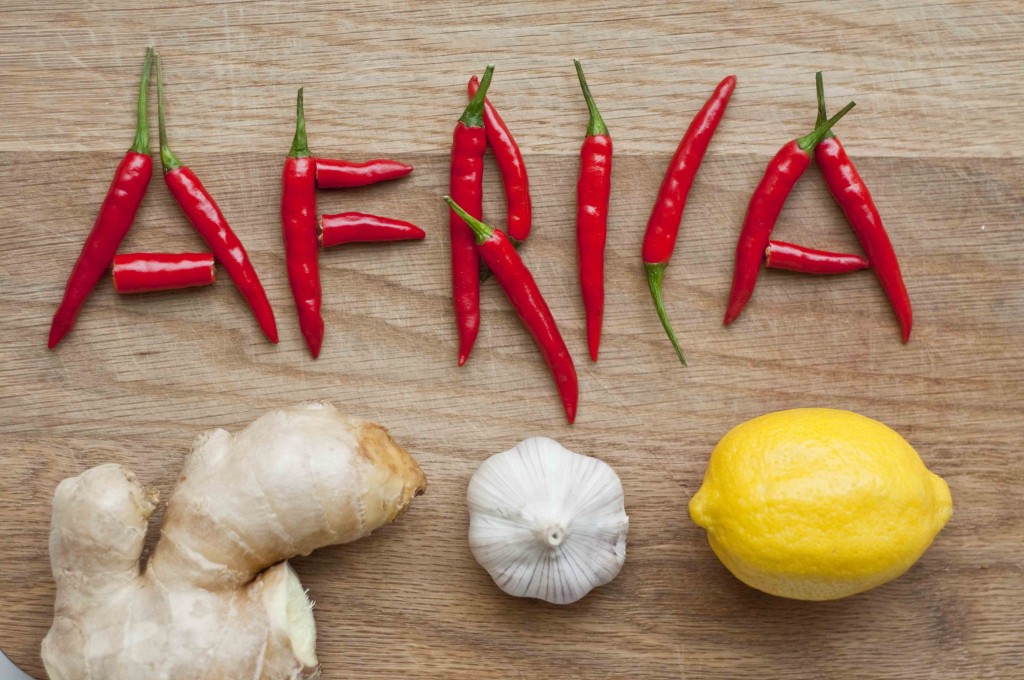Stop 2.. Welcome to AFRICA
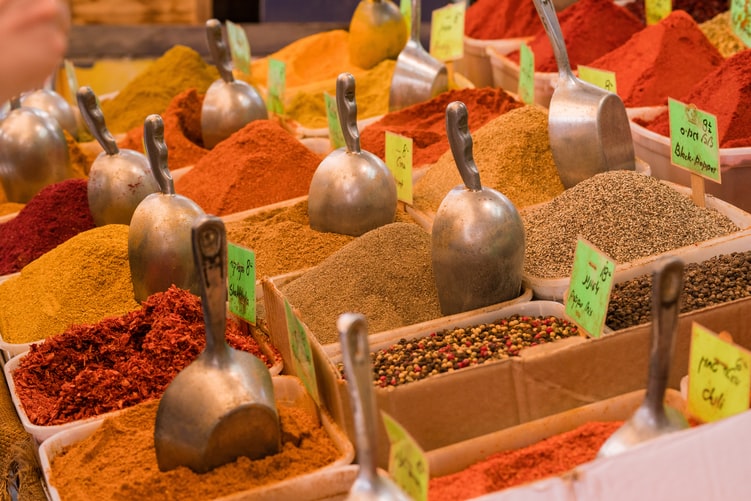
Africa is a continent with clearly defined borders. Surrounded by water from all directions, In the north it is separated from Europe by the Mediterranean Sea, in the northeast, is separated from Asia by the Suez Canal and farther by the Red Sea. From the east and southeast, it is surrounded by the Indian Ocean, from the west by the Atlantic Ocean.
There are 54 independent countries in Africa. Most of the countries were colonized by the European countries, like Spain, Portugal, Italy, France, or Portugal. That changed in a large way, the types of food are eaten there till this day. Although I am happy to say, that the traditional, local cuisine survived and it is thriving, which give us a chance to learn, and to see or try the greatest treasures, passed by generations. In my opinion, there is nothing better, than homemade, traditional food, that make the whole extended family, or village, sit together, and simply enjoy. Most of the time, the regional cuisine, consist of fruits, vegetables and meats that are not extremely sophisticated, but opposite, they are locally grown and cherished.
I must admit that I have tried a dish from few African countries, still not enough. I have so much more to try, and to enjoy, but even though I grow in in Europe, the African cuisine is growing on me, with and unbelievable strength. I just love this kind of food. So simple, yet so amazingly delicious.
Algeria – Couscous
Couscous, which is in fact pasta grain, is steamed, and served with a meat stew braised for few good hours. Always include garbanzo bans, yellow and green squash, sweet potatoes, or butternut squash. You can make only vegetarian version and served with rich vegetable stew.
Angola – Muamba de galinha
or chicken muamba is a dish made with chicken, sauce made from red palm oil (muamba de dendem), garlic, okra and gindungo (variety of Angolan hot chile pepper). Palm oil gives the dish a specific flavor, while lycopene provides the red color
Benin – Klui klui
Peanut fritters. This is the type of food that provides nourishment and protein for people with limited access to food supplies. It is a fried dough made from mashed ground peanuts that are then fried in their own oils.
Botswana- Seswaa
is a traditional meat dish made of beef and goat meat. It is prepared using left over pieces or much tougher cuts such as legs, neck and back. The dish is normally prepared for important ceremonies and national events. The meat is boiled until tender in a pot, with light seasoning and pounded. It is often served with pap (maize meal) or mabele (sorghum)
Burkina Faso – Riz gras
It is a dish consist of rice, and large amounts of meat with addition of vegetables like tomatoes, peppers, cabbage, eggplant, carrots, onions and garlic. The meat stew, well-seasoned, is served over rice
Burundi – Renga renga
Potato leaf chopped up, mixed with seasoning and oil. And with crushed peanuts. Cooked until the mixture come together and looks like leafy peanut stew.
Cabo Verde – Cachupa
It is a rich and filling stew made of beans, grains and heavy seasoned meats. Cooked for many hours, the dish come together in perfect harmony as it developed rich, deep flavor. Depends on the occasion and the financial resources, there are options, just to add pork, or I am more luscious version a lot of meat and even a fish.
Cameroon – Ndolé
A very aromatic spinach stew made of spinach and bitter leaves. As addition flavored with garlic, crayfish, shrimp and beef. Comfort food at its best. Like hot and steamy, meaty spinach dip

Central African Republic (CAR) – Makara
It is a traditional type of bread, made from cassava flour. Pretty thin, and flatbread/pancake look like. Heavier and starchy. Traditionally fried in the oil. Eaten with all sorts of stews of meat and vegetables.
Chad – Boule
This dish is consumed every day, and it is the most common, and eaten daily. Have a Porridge like consistency and it is primarily made from millet in the south and maize in the north. The mixture is shaped into a ball and served with various sauces.
Comoros – Langouste a la vanille
Grilled lobster with vanilla cream sauce, sound extremely appetizing, and that is how it tastes. It is traditionally made with local rock lobster, though any kind of lobster will do for this dish, as will langoustines, shrimp, or even scallops. The sauce itself, do not need any explanation.
Republic of Congo – poulet Yassa
Bone in Chicken, simmer to perfection in a sauce made of lemons and sautéed onions. Served traditionally with fufu, fried plantains, or rice. The same traditional dish as in Guinea and Guinea – Bissau
Democratic Republic of the Congo – Poulet à la Moambé
It is a simple but unbelievably delicious dish. The bone in chicken is simmered in seasoned, tasty sauce, made of palm oil, tomatoes and tomato paste, peanut butter, peppers and chili flakes. Traditionally served with rice, fufu or fried plantains.
Cote d’Ivoire – fufu
It’s a name, that describe a group starchy vegetables ( cassava, yams, or plantains) that have been boiled, pounded into to paste , and rounded into balls; the process, involves a mortar and pestle, can be pretty laborious. Fufu is often dipped into sauces or eaten with stews of meat, fish, or vegetables.
Djibouti – Skoudekharis
This national is a full of flavor rice dish, that is seasoned with cardamom. Cooked with lamb, or sometimes substituted by chicken, beef, or fish.
Egypt – koshari
In a nutshell it is all about kitchen sink dish, whatever you have in your pantry, it will go great. I t is basically comforting bowl of spiced lentils and rice, combined with chickpeas and small pasta. All smothered in a tomato vinegar sauce. Then it is topped with savory, crispy thin fried onion rings.
Equatorial Guinea – Succotash
This vegetarian dish consists of lima beans and other vegetables sautéed with butter and fresh herbs. Depending on preferences, crumbled bacon can be added for extra flavor
Eritrea – Zigni
traditional dish of Eritrean cuisine. It is a beef stew in tomato sauce flavored with berbere (hot spice blend that accompanies almost every dish of the region). Served with regional type of flatbread
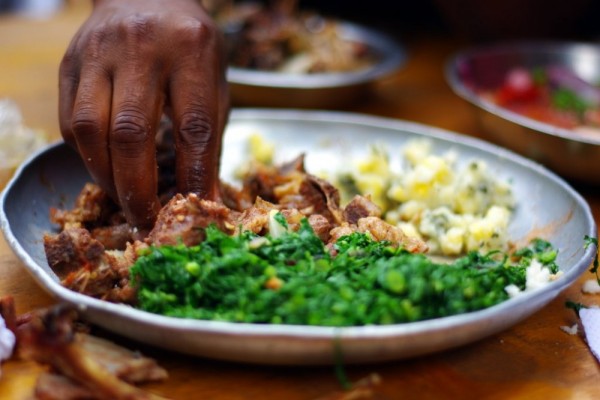
Eswatini (formerly Swaziland)- Karoo roast ostrich steak
In this land ostrich meat is extremely popular, and it is even farmed just for the human consumption. The steak cuts of meat are roast with seasoning and served together with pumpkin mash and topped with a rich cream sauce.
Ethiopia – Doro wat
Ethiopian spiced chicken stew, in luscious sauce. The star of this dish is Berbere spice (very spicy), that is mixed with onions and garlic, to create sauce, in which the chicken and whole eggs will cook for hours, developing this rich and traditional taste. It served with injera, traditional sourdough flatbread.
Gabon – Poulet Nyembwe
Nyembwe means literally palm oil in the Myene language. Basically, Poulet Nyembwe is chicken cooked and flavored with palm oil. Smoked chicken is usually used to prepare it. People of Gabon usually serve hot rice, plantain or mashed yams with this traditional dish.
Gambia – Domoda
Traditionally eaten peanut stew, made in meat or vegetarian version. In addition to pumpkins and sweet potatoes, to keep it meat free, beef, chicken or bushmeat is added for a meat version. Both options are served over rice.
Ghana – Fufu
It’s a name, that describe a group starchy vegetables ( cassava, yams, or plantains) that have been boiled, pounded into to paste , and rounded into balls; the process, involves a mortar and pestle, can be pretty laborious. Fufu is often dipped into sauces or eaten with stews of meat, fish, or vegetables.
Guinea – Poulet Yassa
The same type dish that is traditional in Republic of Congo (see up)
Guinea-Bissau – Poulet Yassa
The same type dish that is traditional in Republic of Congo (see up)
Kenya – Nyama choma
In Swahili language, the name means “grilled or barbequed meat”. Roast goat meat is served up all over the country and always is an occasion to gathering of friends and family., often aided by copious amounts of the local beer.Nyama choma is always eaten with the hands, and common side dishes include kachumbari salad (fresh tomato and onion and chili) and ugali (cooked Maize dough with a little dried cassava dough and water without salt).
Lesotho – Pap-pap
This dish also is a traditional porridge/polenta made from mielie-meal (coarsely ground maize) and a staple food of the African peoples of Southern Africa
Liberia – Dumboy
Fresh cassava is peeled and boiled, while the center fibers are removed. The cooked roots are beaten with a heavy pestle into a smooth uniform paste, then shaped into balls. Before serving, meat stock or hot pepper soup is poured over the dumboy, along with some vegetables.
Libya – Couscous
Stewed beef, sweet potatoes, carrots and garbanzo beans in a spicy hararat (flavorful, aromatic blend of cinnamon, coriander, cumin, red chilies and allspice) tomato sauce, served alongside couscous grain. It is a warming, hearty, comfort dish featuring a delicious blend of Middle Eastern spices.
Madagascar – Romazava
It is a meat stew filled with a combination of green leafy vegetables (mustard greens). It is served over rice which is a staple at every meal.
Malawi – Nsima
Another of the staple food group, made from ground corn and served with side dishes of meat, beans and vegetable. It can be eaten for lunch and dinner. Additionally, served with Kachumbari.
Mali – Tiguadege Na
Meat braised in peanut stew, always with large chunks of carrots and potatoes. Stewed for a few hours.
Mauritania – Thieboudienne
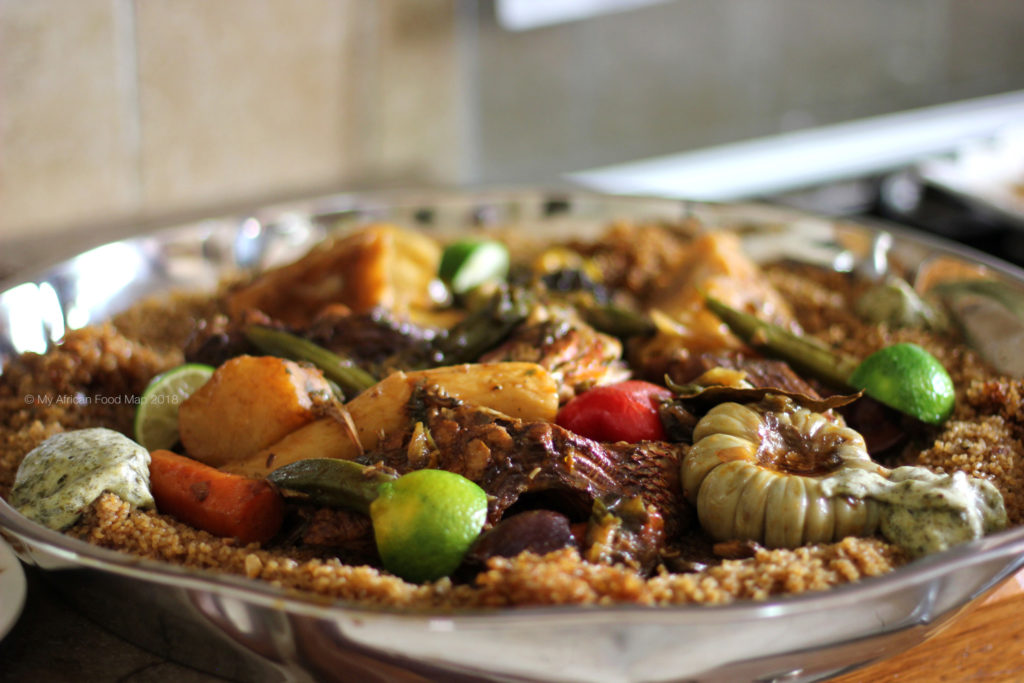
Sometimes called Senegalese Jollof rice (see Nigeria). This dish can be made with an assortment of different vegetables so you can easily use what you like or have on hand, but in its simplicity, it calls for a few unique ingredients. Smoked fish is one which adds great flavor. Next one is a spice called neteto (fermented and ground up bean) This spice has a strong unpleasant scent by itself, but it changes the flavor profile completely while cooking. Usually prepared with broken rice.
Mauritius – Dholl puri
Remarkably like a tortilla but made using yellow split peas. This is then wrapped around any variety of curries and pickled vegetables. lima bean curry and coriander chutney are usually served with it.
Morocco – tagine
Tagine is a clay, cone shaped dish, that is used to make all sort of stew type dishes. Usually cooked for many hours, with beef, lamb or chicken, caramelized onions, fry fruits and aromatic spices. Served on top of couscous or rice.
Mozambique – Piri Piri chicken
The famous Piri Piri, fiery red sauce made up of African birds-eye chilies, lemon juice, vinegar, paprika and other spices, is a Portuguese invention, that was brought to Mozambique by the colonial empire. The sauce is generously applied to the whole chicken, while is grilling over open fire.
Namibia – pap
The same tradition exists here, just like in the Lesotho (see Lesotho), with the same type of national dish.
Niger – Djerma Stew
Peanut chicken stew. Bone in chicken, cooked till tender in a very well-seasoned sauce, based on ground peanuts. With mixture of vegetables. Served over white rice, topped with spring onions.
Nigeria – jollof rice
It is a dish, made with a great amount of spice. A simple rice dish, simmered in reduced tomatoes, onions, peppers, and different set of seasonings depending on where it is made. It is an iconic dish and a staple in celebratory social gatherings, across the West Africa
Rwanda – Ugali
Ugali is the name for the most common mealtime starch: a thick, stiff porridge made from white cornmeal or red millet. Is one of the most common dishes you can find. Served with meat or mashed vegetables, great every possible way.
Sao Tome and Príncipe – Calulu
Dried fish with assortment of vegetables. Onions, tomatoes, okra, sweet potatoes, garlic, palm oil, and gimboa leaves (spinach like); often served with rice, funge (mashed porridge of cassava) or, palm oil beans, and farofa.
Senegal – (Thiéboudienne)
The same idea about tis dish, grow up in Mauretania (see up)
Seychelles – Fruit bat soup
The broth of fruit bat soup is made by washing a bat and throwing it in boiling water, fur included! After it has been cooked for a while, the bat is taken out of the water and cooked with ginger and coconut milk. Other spices as well as vegetables can be added as an addition to the core recipe.
Sierra Leone – cassava
Cassava leaf stew is extremely popular dish across Africa. Its cooked low and slow, with additional vegetables, meats, seafood or just by itself, in its purest form. Always served with rice, or with fufu
Somalia – Canjeero Goat Stew
Goat stew, cooked with green leafy vegetables, potatoes, and sometimes cabbage. Consistency soupier or broths like, than heavy and thick stew, usually served with Canjeero (traditional flatbread), that give this dish its name.
South Africa – Bobotie
It is a well-known South African dish. The traditional version calls for pork, while the more modern one’s switch to beef and lamb. Many recipes incorporated ginger, marjoram and lemon rind or curry powder. Some recipes also call for chopped onions and almonds to be added to the mixture. Traditionally the dish incorporates dried fruit like raisins or sultanas. It is often garnished with walnuts, chutney, and bananas. Bobotie is usually served with “yellow rice”, which is rice cooked with turmeric.
South Sudan – Ful Medames
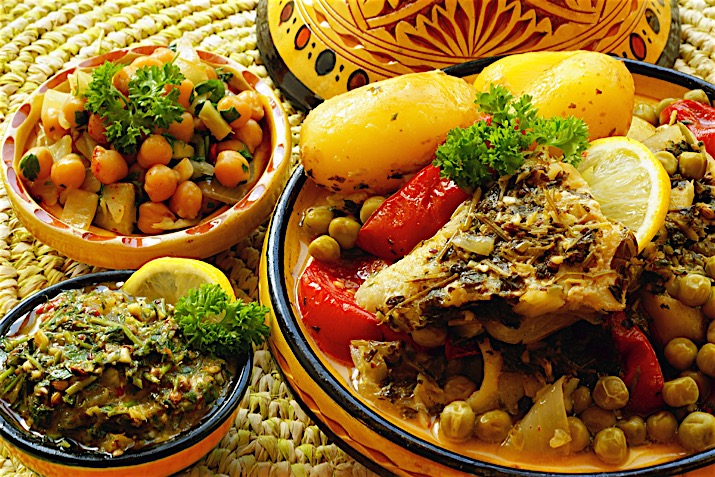
It is a vegetarian protein rich dish garnished with fresh onions, tomatoes, rocket leaves, feta cheese, boiled eggs and sesame oil. Sudanese fava beans are served for breakfast, usually with bread. Fava beans are the main ingredient.
Sudan – Ful Medames
See South Sudan (up)
Tanzania – ugali
See Rwanda (up)
Togo – Ablo
Ablo is a Togolese favorite meal accompaniment, a maize (corn) meal-based flexible bread. Ablo is typically served with soups, stews, vegetable and meat dishes, but is can also be served as a meal, with a dipping sauce.
Tunisia – couscous
Tunisian couscous is another of many variations of this simple, but very satisfying dish, across Northern Africa. The Tunisian version have a spice called harissa (mix of ground chili peppers, garlic, and spices commonly sold together as a paste). It can be made with beef or lamb, with many vegetables, and garbanzo beans. Always cooked with turmeric, that gives it this remarkably yellow color.
Uganda – matoke
Matoke is a variety of banana local to southwest Uganda. Cooked and mashed matoke is used mainly for cooking when they are green and unripe. It can be eaten raw, when fully ripe. Matoke serves as a side dish to all kinds of meat and vegetable stews.
Zambia – Nshima
One of the staple dishes, that every self-respectable wife often makes for her family. A cornmeal porridge with soft and flexible consistency. Nshima is eaten with your hands and often dipped in relishes of meat, beans, and vegetables.
Zimbabwe – sadza
This is a stiff porridge, usually made from maize or corn meal, that in most regions of country is eaten at least twice a day, as a breakfast, lunch, or dinner. Sadza is usually served hot as a side dish accompanying meat or vegetable stews.
where shall we go the next time…???
